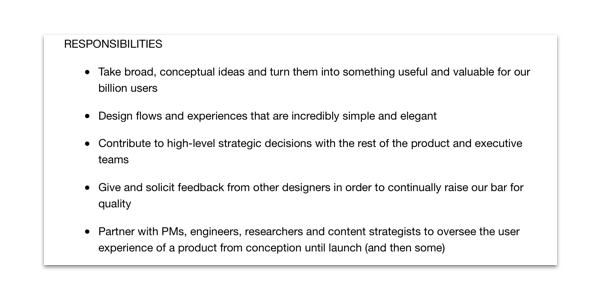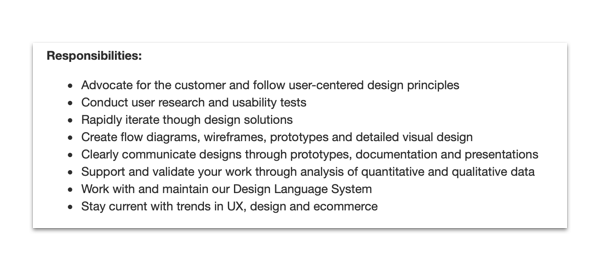Product designer vs. UX designer. While you may assume they’re basically the same thing—they actually focus on different, distinct areas of product development.
With such a broad and ever-growing spectrum of design roles currently on the scene, the comparison between product designer vs. UX designer is frequently hashed out. There seem to be two camps of voters on the issue; many have asserted that there’s very little distinction between the two vocations, and some argue that they’re totally different jobs with clearly defined priorities.
Let’s be clear: product and UX designers do similar jobs on paper. It’s one of the reasons the two roles are so interchangeable—product designers often become UX designers and vice versa.
However, the differences between product design and UX design make themselves known with varying approaches to processes, thinking, and priorities. This comprehensive guide will show all the key differences and similarities of job titles, meaning you’ll never get confused between these two roles again. Here’s what we’ll cover:
- What is a UX designer?
- What is a product designer?
- What are the similarities?
- What are the differences?
- What skills does a UX designer need?
- What skills does a product designer need?
- How much does a UX designer earn?
- How much does a product designer earn?
- The takeaway
Sound good? Let’s dive in!
1. What is a UX designer?
Fundamentally, UX designers focus on user satisfaction and ensuring that the product actually fulfills the user’s needs. They design with user interaction as their main focus, ensuring they’re continually improving the usability and accessibility of the product.
A UX designer will take control of the full scope of the design thinking process, from the research to the ideation, and remain people-driven at all times. Getting into the user’s mindset is integral to the role, as is both user testing and prototyping. In short, they are responsible for ensuring the product is as optimized as possible for the user.
To learn more about what a UX designer actually does, check out this video with pro-UXer, Dee Scarano:
2. What is a product designer?
Fun fact: as product design derives from industrial design, product design has been around for quite a while longer than UX design. Despite this, the anatomy of a product designer remains elusive to many — sometimes including product designers themselves.
A product designer’s role is largely quite flexible, and can be likened to that of a full-stack designer; a multidisciplinary ‘jack of all trades’ designer who does UX, UI, coding, project management and (perhaps most importantly) problem-solving. In short, a product designer designs solutions to the problems that might arise during the initial process.
In order to solve these problems, product designers will assemble teams to facilitate solutions, create multiple test plans, produce wireframes and go through rounds of A/B testing. A product designer will also support the developers through the launch process, as well as working alongside the marketing teams to ensure synergy between the brand and the product.
They are, in short, the guardians of the product: ensuring it’s the most relevant, cost-effective and functional product it can be and that all the stakeholders are happy.
3. What are the similarities?
From the above definitions, you may have already noticed some obvious similarities between the two roles. For starters, both designers will go through the design thinking process and maintain a human-centered approach when it comes to design. Both have a market research aspect to their job (although naturally, the UX designer will delve deeper into user testing).
Alongside these overlapping traits, it’s not uncommon for both UX designers and product designers to use the same tools during the design process. Wireframing tools like Balsamiq and Figma are commonly used by both designers, as well as user mapping software like Lucid Chart and Overflow.
In fact, product designers and UX designers basically use the same tools, with a few exceptions!
4. What are the differences?
Despite these similarities, UX designers and product designers have a fair few differences in their job specs. One of the best ways to distinguish between these two roles is to look at the questions they ask.
A UXer might ask: “Is this product easy to use?” But a product designer would ask, “Does this product make sense in the current economy?”
In UX, you’d ask, “How do I make my design user-friendly?” In product design, you’d ask, “How do I make my design cost-effective?”
From the differences in these questions, you can gauge that the two designers have different priorities. In UX, the priority is usability. In product design, it’s the process, business, cost, and brand. A UX designer will identify the problems, and a product designer will propose solutions.
The general consensus is that compared to UX or UI designers, product designers have a wider range of skills, and therefore a wider range of responsibilities within the project. This is generally reflected in the salary, with product designers often getting paid more due to higher demand.
The average salary for a product designer in the U.S. is $120,661; the average salary for a UX designer is typically lower than this. Of course, this is all relative—it depends on the company, and the scale of the project!
Below is a product designer job description [courtesy of indeed.com]

And below is a UX design job description [courtesy of indeed.com]

Despite the fact that both jobs require a high level of design skill, we can see that there is a higher level of decision-making and business acumen required in the product designer job spec, whereas the UX design job spec involves more specific design responsibilities including research and wireframes.
5. What skills does a UX designer need?
When researching UX design roles on Indeed and Glassdoor, we found that common requirements include:
- Strong understanding of the UX design process
- Proficiency in industry-standard design and prototyping tools such as Figma
- Experience in planning and conducting user research and competitor analysis
- The ability to interpret data and qualitative feedback
- Experience in creating user stories, personas, and storyboards
- Determine information architecture and create sitemaps
- Prototyping and wireframing skills
- Understanding of interaction design principles
- Understanding of business metrics and the ability to translate company goals and objectives into digital experiences
To learn more, check out our handy guide on how to write and interpret UX design job descriptions.
6. What skills does a product designer need?
Based on various job postings found on Indeed and Glassdoor, some of the required skills for a product designer role include:
- Relevant undergraduate degree or formal qualification
- 3+ years of professional experience UX/UI design
- Proficiency in industry-standard design and prototyping tools such as Figma
- A strong understanding of how to apply design thinking when planning and scoping project work
- Experience in contributing towards a design system
- A portfolio that demonstrates functional designs across desktop and mobile devices
- A user-centric mindset
- Strong wireframing/prototyping skills
- Experience conducting research/partnering with user researchers
- Experience partnering with engineers to release features, products, and/or services
- Experience working on complex applications
- Strong visual and verbal communication skills
- Strong cross-functional collaboration and communication skills
7. How much does a UX designer earn?
Salaries for user experience designers vary depending on the location, industry, and years of experience. According to Glassdoor’s salary data, you will likely earn about $50k-$70k a year as a Junior UX Designer in The States. Designers with roughly ten years of experience can earn close to $185,000 a year.
To help give you an idea of what the UX design market looks like today, here’s a global snapshot of the average yearly UX designer salaries at the end of 2023, based on data provided by Glassdoor.
- United States: US$94,614
- Canada: US$59,244 (CA$78,917)
- Germany: US$58,932 (€53,700)
- United Kingdom: US$60,658 (£47,884)
- Australia: US$68,377 (AU$101,000)
8. How much does a product designer earn
Depending on your experience and the sector you’re working in, Product Designers typically make between $50k-$128k in the United States. To help give you an idea of what you could expect to earn as a product designer, here’s a global snapshot of average product designer salaries based on data provided by Glassdoor.
- United States: US$81,179 per year
- Canada: US$63,610 (CA$84,732)
- Germany: US$65,846 (€60,000)
- United Kingdom: US$62,499 (£49,337)
- Australia: US$80,563 (AU$119,000)
9. The takeaway
The main takeaway from this comparison is that product designers and UX designers have very similar jobs—but it’s arguable that a product designer has a few more responsibilities in terms of thinking of the process as a whole, including the business, process, and branding.
That’s not to say that a product designer does more work than a UX designer! Depending on the product and company, it’s likely that both roles will involve the same level of hard work and dedication to ensuring the product is the best it can possibly be. In fact, the roles are so similar that they’re easily interchangeable.
This is one of the reasons why product designer to UX designer and vice versa are extremely well-trodden career paths.
Hopefully, this piece will have provided you with a clear distinction between the two job specs.
Looking to dive into the world of Product Design? Try our free short course or speak with a program advisor.
For further reading about different roles and specializations in UX design, check out our articles on:
